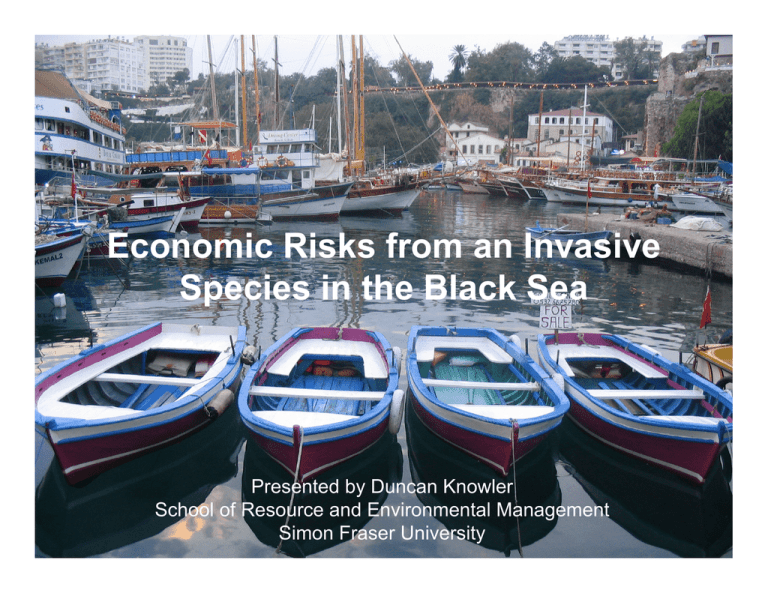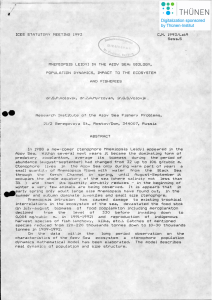Economic Risks from an Invasive Species in the Black Sea
advertisement

Economic Risks from an Invasive
Species in the Black Sea
Presented by Duncan Knowler
School of Resource and Environmental Management
Simon Fraser University
1
Overview
• Case study background: Black Sea problem
• Management objectives
• Basic relationships and assumptions
• Stochastic process: invasive spp outbreaks
• Risk analysis using a bioeconomic model
• Implications of alternative trigger mechanisms
• Conclusions: risk analysis aspects
2
3
Problem definition
• Black Sea drains 50% of Europe; major tributary is
the Danube River
• It is subject to severe environmental pressures, e.g.
eutrophication, toxics, overfishing, etc.
• Invasion of the Black Sea by the comb jelly
“Mnemiopsis leidyi”
• Cumulative impact on fisheries (e.g. anchovy) from
all pressures has been substantial
• Coordination of several riparian countries to
address problems is difficult
4
The Comb Jelly “Mnemiopsis leidyi”
5
Management objectives
• Need to address pollution pressures, especially
nutrient loads, and fisheries management
• Some fish species (e.g. anchovy) have a complex
interaction with nutrients, a ‘mixed blessing’ effect
• What triggers stochastic Mnemiopsis events: sea
temperature or nutrient loads?
• Critical to assess the influence of nutrient
abatement policies under alternative triggering
assumptions
• What escapement policy is optimal for modeling?
• Response is to model this system using a
stochastic bioeconomic modeling approach
6
Description of system processes
7
Relationship
Between
Nutrients,
Mnemiopsis
and Anchovy
Population
Dynamics
(+)
(-)
Key uncertainties:
1. What triggers
Mnemiopsis
outbreaks?
•
Sea temperatures or
nutrient load?
2. What should the
escapement level
be for the anchovy
stock?
•
Constant escapement
optimal?
?
8
Some key modeling assumptions
• Recurring Mnemiopsis outbreaks have identical
impacts on the anchovy stock
• Outbreaks are determined by a time-varying
random threshold or trigger
• Fishery managers know relevant probability
distributions and magnitudes and are risk neutral
• Whether an outbreak will occur is unknown until
after fish escapement is decided for that period
• Management is evaluated using expected
economic profits from the anchovy harvest, as
determined by an optimization procedure
9
Stochastic process
• Stochastic transition equation:
where X is anchovy stock, S is anchovy
escapement, P is phosphates and σi, Ri(S,P) are
survival and recruitment under state of the world i
• State i = 1 is normal conditions while i = 2 refers to
an outbreak. [Note: derivative RP > 0]
• Stochastic variable Zt is the unknown threshold at
time t that triggers a Mnemiopsis outbreak
• Consider (i) sea surface temperature and
(ii) nutrient level as triggering mechanisms
10
• Following expression describes the probability
mass function governing the stochastic transition
equation:
• Denote the first probability as Λ(Pt,Tt) and the
second as Φ(Pt,Tt)
• It follows that Λ(Pt,Tt) = 1 - Φ(Pt,Tt), Φ’ = f(Zt) > 0
and Λ’ = -f(Zt) < 0.
11
Black Sea anchovy-Mnemiopsis model
and nutrient abatement implies:
12
Nutrient abatement under alternative
triggering mechanisms
1. Sea temperature
2. Nutrients
13
Results for Stochastic Model for Varying Mean Threshold
Values, Assuming 50% Impact of Mnemiopsis and a 50%
Nutrient Abatement Policy (P = 2.75 µM; US$ 1989/90)
No Nutrient Abatement
Mean
Thres
–hold
(1)
Outbreak
probability
(2)
Optimal
escapement
('000 t)
50% Nutrient Abatement
(3)
Expected
profits
($'000/yr)
(4)
Outbreak
probability
(5)
Optimal
escapement
('000 t)
(6)
Expected
profits
($'000/yr)
(6) – (3)
Benefits of
abatement
($'000/yr)
Sea Surface Temperature Triggers Outbreaks
3.0°C
0.66
1233
7106
0.66
1082
5736
(1370)
3.5°C
0.60
1259
7887
0.60
1116
6405
(1482)
4.0°C
0.55
1281
8581
0.55
1146
7001
(1580)
Nutrient Loads Trigger Outbreaks
3 µM
0.84
1153
4779
0.60
1232
6393
1614
6 µM
0.60
1258
7874
0.37
1338
9438
1564
9 µM
0.46
1325
9981
0.26
1387
10,962
981
14
Conclusions: risk analysis aspects
• Indicators of risk
‘Expected value’ analysis
• List of management options
Unspecified pollution control policies
• Uncertainties analyzed quantitatively?
Key uncertainty is the triggering mechanism
• Ways of taking into account uncertainties
about inputs to the analysis
Used exponential distribution to model risk
• Analysis of sensitivity of conclusions
Varied key parameter values
15
Thank You
School of Resource and Environmental Management
Simon Fraser University
16






